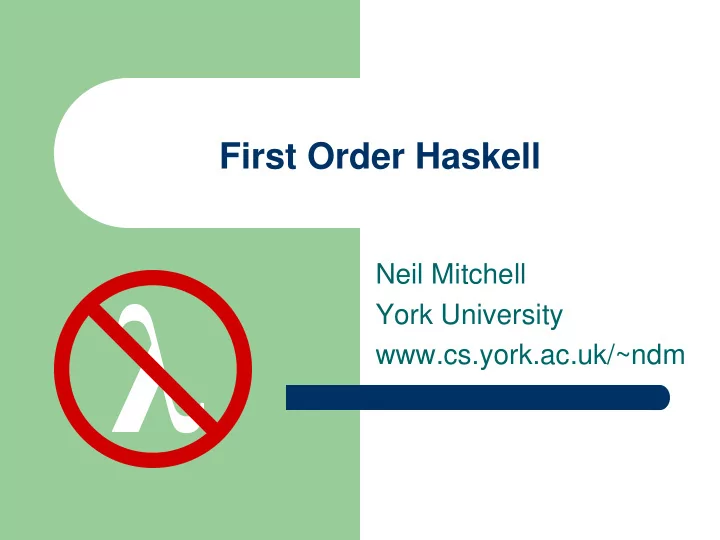

First Order Haskell Neil Mitchell λ York University www.cs.york.ac.uk/~ndm
First order vs Higher order Higher order: functions are values – Can be passed around – Stored in data structure Harder for reasoning and analysis – More syntactic forms – Extra work for the analysis Can we convert automatically? – Yes (that’s this talk!)
Which are higher order? [not x | x ← xs] let xs = x:xs in xs putChar ‘a’ foldl (+) 0 xs \x → not x map not xs 1 not . odd (+1) a < b not $ odd x const ‘N’
Higher order features Type classes are implemented as dictionaries a → a → Bool – (==) :: Eq a – (==) :: (a → a → Bool, a → a → Bool) → a → a → Bool Monads are higher order m a → (a → m b) → m b – (>>=) :: Monad m IO is higher order – newtype IO a = IO (World → (World, a))
A map example map f [] = [] map f (x:xs) = f x : map f xs heads xs = map head xs head is passed higher order map takes a higher order argument heads could be first order
John C. Reynolds, Definitional Interpreters for Higher-Order Programming Languages Reynold’s Style Defunctionalisation data Func = Head apply Head x = head x map f [] = [] map f (x:xs) = apply f x : map f xs heads xs = map Head xs Move functions to data
Reynold’s Style Defunctionalisation Good – Complete, works on all programs – Easy to implement Bad – No longer Hindley-Milner type correct – Makes the code more complex – Adds a level of indirection – Makes program analysis harder
Specialisation map_head [] = [] map_head (x:xs) = head x : map_head xs heads xs = map_head xs Move functions to code
Specialisation Find: map head xs – A call to a function (i.e. map) – With an argument which is higher order (i.e. head) Generate: map_head xs = … – A new version of the function – With the higher order element frozen in Replace: map_head xs – Use the specialised version
Specialisation fails (.) f g x = f (g x) even = (.) not odd check x = even x Nothing available to specialise! Can be solved by a simple inline check x = (.) not odd x
An algorithm Specialise as long as possible 1. Inline once 2. Goto 1 3. Stop when no higher order functions remain
Algorithm fails data Wrap a = Wrap (Wrap a) | Value a f x = f (Wrap x) check = f (Value head) In practice, this is rare – requires a function to be stored in a recursive data structure and … Detect, and revert to Reynold’s method
Mark Jones, Dictionary-free Overloading by Partial Evaluation Code Size Specialisation approach reduces code volume – Average about 55% smaller code (20%-95% range) 3000 2500 Higher order Lines of Code 2000 First order 1500 1000 500 0 Nofib Programs (Imaginary)
Current uses Performance optimiser – The first step, makes the remaining analysis simpler – Already increases the performance Analysis tool – Catch, checking for pattern match safety – Keeps the analysis simpler Implemented for Yhc (York Haskell Compiler)
Conclusion Higher order functions are good for programmers Analysis and transformation are simpler in a first order language Higher order functions can be removed Their removal can reduce code size
Recommend
More recommend